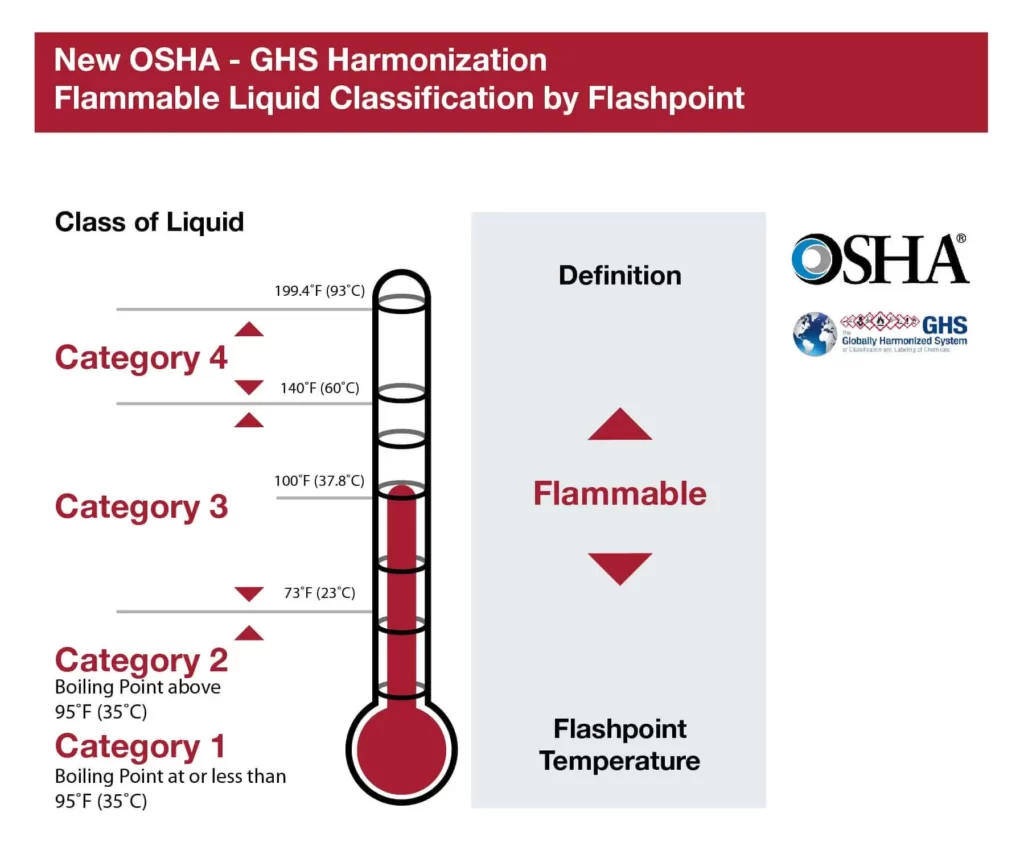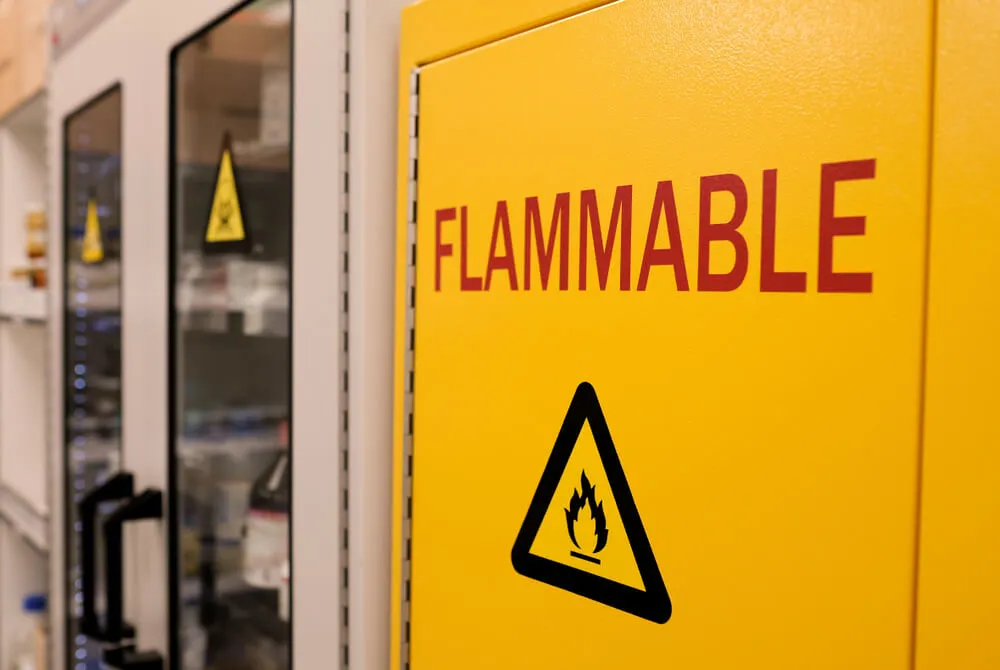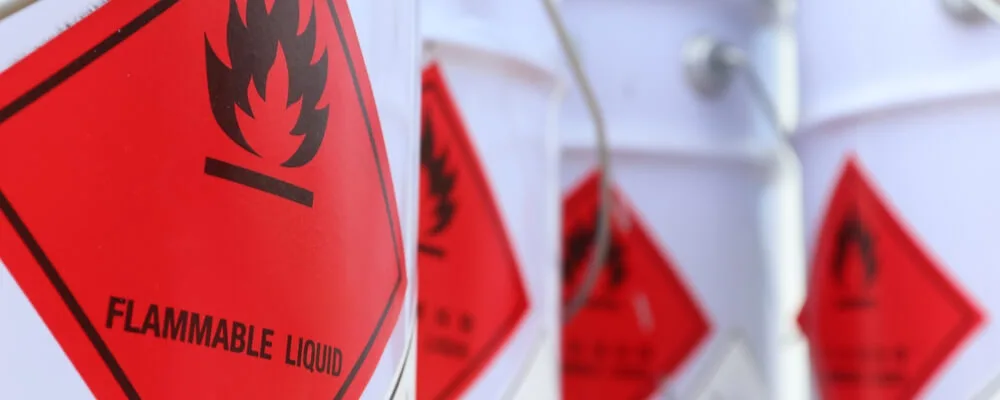Understanding the differences between flammable and combustible substances is crucial, especially when managing risk in environments with these materials. In our comprehensive guide, we dive into the world of hazardous materials and explore these two categories in depth. From defining the basics to unpacking the nuances that separate flammable from combustible materials, this blog post is designed to provide an in-depth understanding. We will also shed light on the regulations governing their use, explain safety precautions, and highlight important aspects of storage and handling.
Whether you work directly with these materials or are just interested in expanding your knowledge, this blog will serve as a useful resource to enhance safety, promote understanding, and inform effective practices. So, let’s delve into the distinct world of flammable and combustible substances and learn about the 10 key differences that set them apart.
What is Flammable?
Flammable refers to a substance or material that can ignite or catch fire easily at a specific range of temperatures. This property is determined by the flash point of the material. The flash point is the lowest temperature at which the vapors of a volatile material can ignite when an ignition source like a flame or spark is present.
Flammable materials are characterized by a flash point below 37.8°C (100°F). These materials are a greater fire hazard because they can ignite at room temperature or temperatures commonly encountered. Examples of flammable substances include gasoline, alcohol, and many organic solvents.
It’s crucial to remember that it’s not the liquid that burns but the vapors it gives off. These vapors can ignite and cause a fire or explosion when mixed with air in the right proportions and exposed to an ignition source. For this reason, handling and storage of flammable materials require specific safety measures to minimize the risk of a fire or explosion.

What is Combustible?
The term “combustible” refers to a substance or material that can catch fire and burn. The key factor distinguishing combustible materials from flammable ones is the temperature at which they ignite, known as the flash point.
Combustible liquids typically need to reach higher temperatures than flammable liquids to catch fire. In essence, the flash point of a combustible liquid is higher than that of a flammable liquid. This higher flash point means combustible liquids generally pose less immediate fire risk under normal working conditions than flammable liquids. However, they can still pose significant fire hazards under the right circumstances.
Knowing the flash point and other combustion properties of any potentially combustible materials you work with is essential. This understanding enables you to take appropriate precautions in handling, storing, and disposing of these substances to maintain a safe environment.

Key Differences Between Flammable and Combustible
While both flammable and combustible substances have the potential to catch fire, the key differences between them lie in the specific temperatures or flash points at which they ignite. Here are the main differences:
| Aspect | Flammable Substances | Combustible Substances |
|---|---|---|
| Definition | Materials that easily catch fire and ignite at or below their flash point. | Materials that burn at higher temperatures and require higher ignition sources. |
| Flash Point | Low flash point (e.g., gasoline) | Higher flash point (e.g., wood) |
| Ignition Temperature | Low ignition temperature | Higher ignition temperature |
| Flammability Range | Wide flammability range | Narrow flammability range |
| State | Can be in gas, liquid, or solid form. | Typically found as solids. |
| Volatility | High volatility | Lower volatility |
| Examples | Gasoline, alcohol, propane | Wood, paper, cloth, cardboard |
| Fire Risk | High fire risk | Lower fire risk |
| Fire Suppression | May require specialized extinguishing agents due to higher volatility. | Traditional fire extinguishers often effective. |
| Regulatory Standards | Governed by specific regulations and safety guidelines. | Subject to safety regulations as well. |
| Environmental Impact | Accidental spills can lead to rapid fires and environmental hazards. | Slower burning, may have less immediate environmental impact. |
| Special Considerations | Special precautions needed for storage, transportation, and handling. | Still require safety measures but not as stringent. |
1. Flash Point
This is the lowest temperature at which a substance will ignite. Flammable substances have a lower flash point than combustible substances, which ignite at lower temperatures and present a higher risk in normal working conditions. In general, a substance is considered flammable if its flash point is less than 100°F (37.8°C), while a substance is considered combustible if its flash point is between 100°F and 200°F (37.8°C and 93.3°C).
2. Ignition Temperature
Combustible materials typically require higher temperatures to ignite than flammable ones. This means combustible materials may not ignite in the same conditions that would cause flammable materials to catch fire.
3. Risk Level
Because flammable substances ignite at lower temperatures, they tend to pose a greater fire risk under normal conditions than combustible substances. However, both types can pose significant fire hazards under the right circumstances.
4. Rate of Combustion
Flammable substances typically burn faster and more violently than combustible substances due to their lower flash point and ignition temperatures. However, both can cause damaging fires if not properly controlled.
Remember, it’s important to handle and store both flammable and combustible substances properly to prevent fires. This includes keeping them away from ignition sources and following safety guidelines regarding their use and storage.

Other Differences Between Flammable and Combustible
In addition to the previously mentioned differences, the following are additional distinctions between flammable and combustible substances:
It is essential to remember that both flammable and combustible substances can be hazardous and require careful handling, storage, and disposal. Always refer to Material Safety Data Sheets (MSDS) or Safety Data Sheets (SDS) for specific safety information about each substance.

Where To Store Flammables And Combustibles
The storage of flammable and combustible liquids is a crucial part of maintaining a safe working environment. Following the recommended guidelines is important to reduce the risk of fires and explosions.
General Guidelines
- Designated Areas: Flammable and combustible materials should be stored in specially designated areas or storage cabinets to resist fire and contain leaks and spills.
- Temperature Control: Keep the storage area cool and dry. The area should be well-ventilated to prevent the build-up of vapors, and it should not be exposed to open flames, sparks, or any ignition sources.
- Accessibility: The storage area should be easily accessible to quickly respond to emergencies and restrict unauthorized access.
- Proper Labeling: All storage areas and containers should be clearly labeled, indicating their hazard. This helps in immediate recognition of the potential hazards in case of an emergency.
- Quantity Limitations: Avoid excessive storage of flammable and combustible liquids. Only keep quantities necessary for the operation at hand. This minimizes the potential fuel for a fire and the risk of spills.
Specific Guidelines
- Safety Containers: Flammable and combustible liquids should be stored in safety containers that meet the specifications of organizations like OSHA or NFPA. Safety cans are usually made of metal and are equipped with flame arresters and pressure relief mechanisms.
- Safety Cabinets: If flammable and combustible liquids exceed 10 gallons (38 liters) in a building, they should be stored in flammable liquid storage safety cabinets. These cabinets are designed to protect the contents from fire for up to 10 minutes, giving people enough time to evacuate and the fire department time to respond.
- Storage Rooms: If the quantity of flammable and combustible liquids exceeds the maximum allowable limit in safety cabinets, they should be stored in specially designed storage rooms. These rooms should be constructed to withstand fire for up to 2 hours.
- Storage Tanks: Storage tanks might be necessary for extremely large quantities of flammable and combustible liquids. Aboveground tanks should be avoided if possible, but they should be located safely from buildings and property lines.
These guidelines are meant to minimize the risk of storing flammable and combustible materials. Always consult the latest regulations and guidelines from your local fire department and OSHA for the most accurate and up-to-date safety practices.

Safety Training and Education For Flammable and Combustible
Safety training and education are crucial in reducing the risk of handling flammable and combustible materials. Such training helps employees understand the risks, preventative measures, and proper response in case of an incident. Here are some key components that should be included in safety training and education for handling flammable and combustible materials:
- Understanding Material Properties: Educate employees about the properties of the flammable and combustible materials they work with. This should include understanding Material Safety Data Sheets (MSDS) and recognizing hazard symbols and labels.
- Handling and Storage: Employees should be trained on properly handling and storing flammable and combustible materials. This includes understanding the importance of using the right tools and equipment, ensuring proper ventilation, and adhering to storage guidelines.
- Emergency Procedures: Training should cover what to do during a spill, fire, or other emergency. This includes knowing how to use fire-fighting equipment, understanding evacuation procedures, and learning how to respond to different types of fires (for example, using a water extinguisher on a flammable liquid fire can be dangerous).
- Disposal of Flammable and Combustible Waste: Employees should be trained on the correct disposal methods of waste containing flammable or combustible materials, including using proper waste containers and disposal facilities.
- Personal Protective Equipment (PPE): Training should also involve knowing which types of personal protective equipment to use when handling these materials, how to properly use and maintain this equipment, and understanding its limitations.
- Regular drills: Regular drills can ensure employees know how to react in an emergency. These drills include evacuation procedures, fire extinguishers, and spill containment handling.
- Ongoing Training: Safety training should be ongoing to account for changes in regulations, the introduction of new materials or processes, and to reinforce safety principles. Refresher courses should be held regularly to ensure that the information remains fresh in employees’ minds.
In conclusion, safety training and education are essential to a comprehensive safety program when working with flammable and combustible materials. The goal of the training should be to instill a safety culture where all employees understand the risks associated with their work and know how to take the necessary precautions.
Conclusion
In conclusion, understanding the distinction between flammable and combustible materials is paramount for maintaining safety in any environment where these substances are used. While often used interchangeably in the common language, the terms flammable and combustible refer to different categories of hazardous materials regarding safety and fire regulations.
Their key difference lies in their flash points or the lowest temperature at which they can ignite. Flammable materials ignite at lower temperatures and pose a higher risk than combustible ones. Furthermore, how these materials are stored, handled, and disposed of can significantly impact safety and potentially mitigate the risk of a fire or explosion.
As we explored the ten key differences between flammable and combustible substances, we learned that these differences have profound implications for safety protocols and procedures. Thus, this knowledge is theoretical and has practical applications in various fields, from construction and manufacturing to transportation and storage.
By keeping these differences in mind and adhering to the guidelines set forth by safety and health administrations, we can effectively manage the risks associated with flammable and combustible materials. Ultimately, the primary goal is to ensure the safety of all individuals who work with or around these substances.

